
maniei.ir
یاد من باشد فردا حتما باور این را بکنم، که دگر فرصت نیست و بدانم که اگر دیر کنم ،مهلتی نیست مرا و بدانم که شبی خواهم رفت و شبی هست، که نیست، پس از آن فردایی
maniei.ir
یاد من باشد فردا حتما باور این را بکنم، که دگر فرصت نیست و بدانم که اگر دیر کنم ،مهلتی نیست مرا و بدانم که شبی خواهم رفت و شبی هست، که نیست، پس از آن فرداییدرباره من
نظرسنجی
روزانهها
همه- Favism
- لوگو آنلاین
- نحوه ساخت کاردستی
- kalam.tv
- Network Monitoring
- network-tools
- satellite
- Satellite Finder
- delicast
- livestation
- iranava
- iransima
- Earthcam
- خدمات الکترونیک
- parsquran
- Maniei
- online TV
- talkdigger
- Snap
- football
- photofunia
- av-comparatives
- New daily proxies
- visiocafe
- My Network Diagram
- Kaspersky Key
- command line
- تست سرعت اینترنت
- قرآن کریم
- عتبات عالیات
- جدیدترین اخبار
- سازندگان سخت افزار
- فرهنگ لغت آریا
- فروشگاه موبایل
- عکس
- جمکران
پیوندها
دستهها
برگهها
جدیدترین یادداشتها
همه- غیرفعال کردن اخطار ورود ناامن در فایرفاکس
- DVR
- EtherChannel
- Debian 9
- اجرای نرم افزارهای ویندوز روی مک
- پیامکهای تبلیغاتی
- بهینهسازی فلش مموری
- بهینهسازی فلش مموری
- بهینهسازی فلش مموری
- windows
- نصب قلمهای فارسی در اوبونتو
- امنیت شبکه
- Firefox 44
- (Free & Public DNS Servers (Valid December 2015
- Best Free Public DNS Servers
- Disable TCP/IP auto-tuning
- Ubuntu:Problem to enter in NTFS partition
- Western Digital
- Bing Maps
- sticky note
- Robot Taxi
- Skype
- dislike
- Android 5.x
- iOS 9
نویسندگان
- مجتبی منیعی 430
بایگانی
- فروردین 1396 1
- تیر 1395 1
- خرداد 1395 1
- اردیبهشت 1395 1
- فروردین 1395 5
- اسفند 1394 1
- بهمن 1394 3
- دی 1394 3
- آذر 1394 3
- آبان 1394 1
- مهر 1394 2
- شهریور 1394 6
- مرداد 1394 4
- تیر 1394 3
- خرداد 1394 13
- اردیبهشت 1394 4
- فروردین 1394 1
- اسفند 1393 6
- بهمن 1393 1
- دی 1393 3
- آذر 1393 2
- آبان 1393 1
- مهر 1393 2
- شهریور 1393 4
- مرداد 1393 1
- تیر 1393 18
- خرداد 1393 11
- اردیبهشت 1393 2
- فروردین 1393 8
- اسفند 1392 1
- بهمن 1392 3
- دی 1392 2
- آذر 1392 1
- آبان 1392 2
- مهر 1392 2
- شهریور 1392 3
- مرداد 1392 4
- تیر 1392 3
- خرداد 1392 2
- اردیبهشت 1392 4
- فروردین 1392 4
- اسفند 1391 4
- بهمن 1391 2
- دی 1391 2
- آذر 1391 1
- آبان 1391 7
- مهر 1391 4
- شهریور 1391 1
- مرداد 1391 2
- تیر 1391 2
- خرداد 1391 5
- اردیبهشت 1391 6
- فروردین 1391 2
- اسفند 1390 1
- بهمن 1390 4
- دی 1390 4
- آذر 1390 1
- آبان 1390 3
- مهر 1390 5
- شهریور 1390 3
- مرداد 1390 5
- تیر 1390 5
- خرداد 1390 4
- اردیبهشت 1390 5
- فروردین 1390 6
- اسفند 1389 1
- بهمن 1389 2
- دی 1389 1
- آبان 1389 12
- مهر 1389 2
- شهریور 1389 3
- مرداد 1389 1
- تیر 1389 7
- خرداد 1389 1
- اردیبهشت 1389 4
- فروردین 1389 2
- اسفند 1388 3
- بهمن 1388 1
- دی 1388 11
- آذر 1388 1
- آبان 1388 4
- مهر 1388 3
- شهریور 1388 5
- مرداد 1388 3
- تیر 1388 1
- خرداد 1388 1
- اردیبهشت 1388 1
- اسفند 1387 3
- بهمن 1387 9
- آذر 1387 1
- آبان 1387 2
- مهر 1387 5
- تیر 1387 1
- خرداد 1387 1
- اردیبهشت 1387 8
- فروردین 1387 11
- اسفند 1386 9
- بهمن 1386 8
- دی 1386 11
- آذر 1386 11
- آبان 1386 26
- مهر 1386 15
- شهریور 1386 12
تقویم
فروردین 1396| ش | ی | د | س | چ | پ | ج |
| 1 | 2 | 3 | 4 | |||
| 5 | 6 | 7 | 8 | 9 | 10 | 11 |
| 12 | 13 | 14 | 15 | 16 | 17 | 18 |
| 19 | 20 | 21 | 22 | 23 | 24 | 25 |
| 26 | 27 | 28 | 29 | 30 | 31 |
جستجو
You can now search for Instagram users, hashtags or locations online

Instagram, once a mobile only party, is now enhancing its web experience. A month after updating the app’s search and explore features, Instagram has brought searchability to their website too. On Monday a search bar appeared at the top of Instagram’s website that allows users to search by hashtag, user name or location. This update separates Instagram from other mobile-first apps such as Snapchat that have skipped the desktop aspect altogether
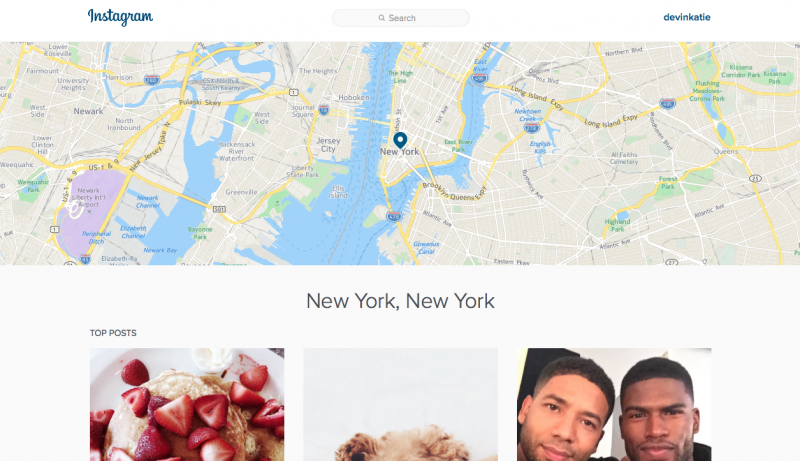
Search for a hashtag or location and you'll find a landing page that displays the most popular results first, with the most recent photos farther down. This update is a welcome change as the website has remained pretty sparse since its launch in 2012, although admittedly any website was better than not having one at all as it was the case initially
Now it appears that Instagram wants to minimize the disparity between the app and the website, and the search feature is a good step towards that. Also, as web embeds of their content drive more traffic, it’s sound business to have a site that is a positive experience for web users
This doesn’t mean that Instagram is going to start favoring web over mobile anytime soon, they remain a mobile-first operation. But, for now, being able to search for everything online is enough. The company also recently began storing pictures at 1080×1080 pixels, a big increase over the standard 640×640 pixel resolution
AMD
AMD launches another desktop APU, the A8-7670K
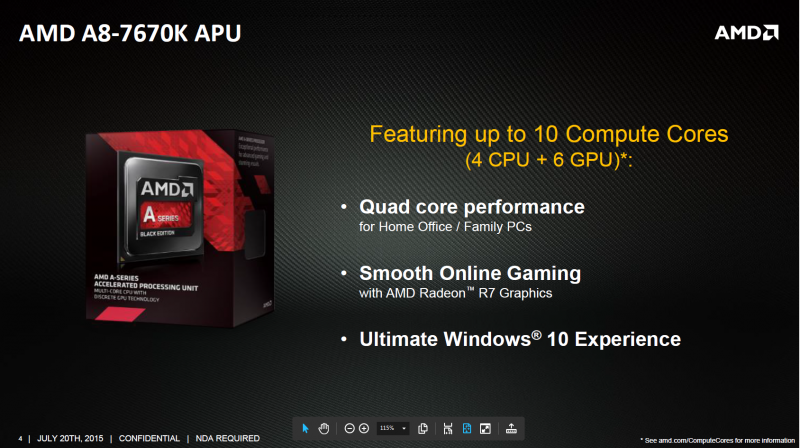
While Intel has dominated the high-performance CPU market for years, AMD continues to provide value to those on a budget with their reasonably attractive range of APUs. Today, the company has announced a new APU, the A8-7670K, that slots into their 'Godavari' line-up alongside the A10-7870K
The A8-7670K is an affordable socket FM2+ APU built on a 28nm process. It features four Excavator CPU cores clocked at 3.6 GHz with a turbo speed of 3.9 GHz, as well as six Radeon R7 graphics compute units clocked at 757 MHz, and 4 MB of L2 cache. Essentially this APU is a revision of the older A8-7650K with higher clock speeds across the board
According to AMD, the A8-7670K unsurprisingly outperforms a more expensive combination of an Intel Pentium G3258 CPU and Nvidia GT 730 GPU in a range of popular PC games including Dota 2 and Counter-Strike: Global Offensive. Due to stronger integrated graphics it's also faster than Intel's Core i3-4160 in compute workloads, even though Intel's Core i3 has superior CPU performance
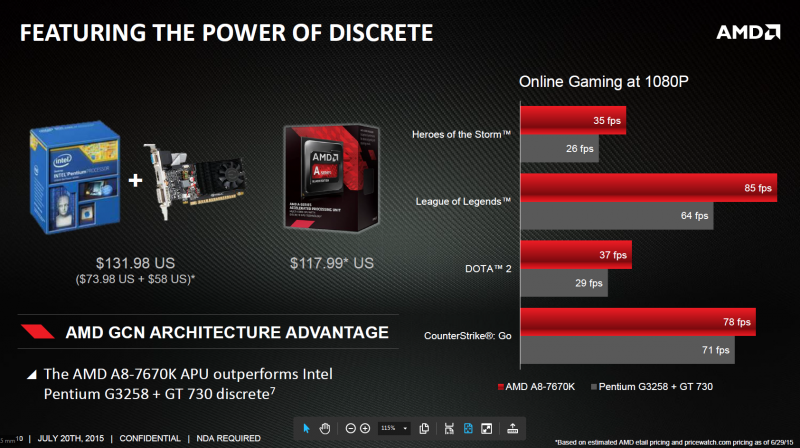
AMD fully supports Windows 10 and DirectX 12 running on the A8-7670K, and the APU also supports FreeSync, Dual Graphics, and Virtual Super Resolution. These features are also supported on AMD's older Kaveri APUs, so it isn't a surprise to see the features supported in Godavari products
The A8-7670K is now available from a range of retailers for $117.99, two dollars less than the Intel Core i3-4160
Windows 10
Automatic updates: Microsoft adds double-edged sword clause in Windows 10 Home
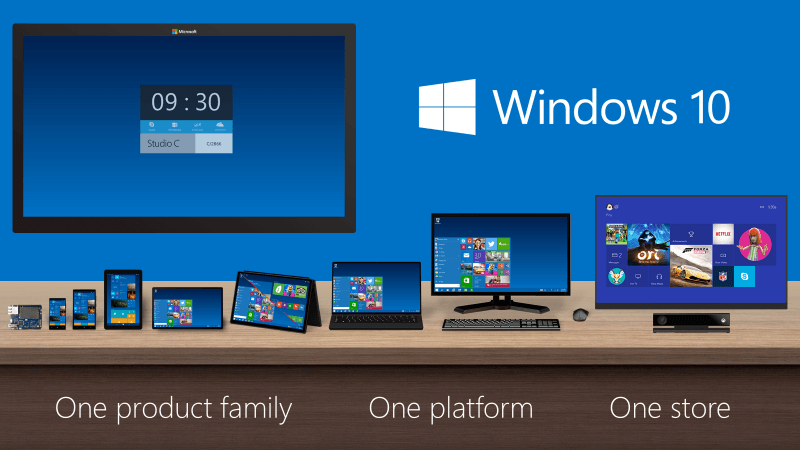
Microsoft is set to begin the rollout of Windows 10 on July 29. As the final version of Windows, the Redmond-based company is moving away from big releases and will instead issue incremental updates to keep the OS up to speed
Automatic updates aren’t anything new in Windows but if you’re planning to purchase or otherwise upgrade to Windows 10 Home edition, you need to know that Microsoft will install updates and new features automatically whether you like it or not
In the final version of Windows 10 that was distributed to beta testers this week, Microsoft added a small clause to its end user license agreement (EULA) which states that users will receive automatic updates without any additional notice. In other words, the updates will be mandatory (unless you disconnect from the Internet, I suppose)
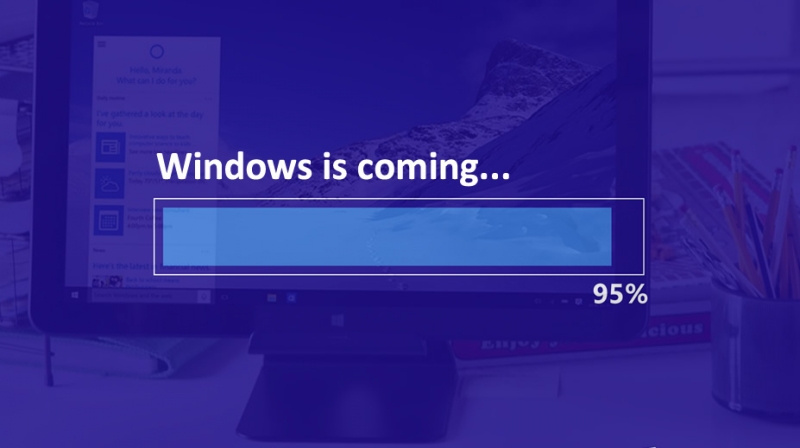
It’s a bold move, one that some will no doubt view as a double-edged sword
Having the latest security patches and features installed seems like a noble cause that would protect users from various vulnerabilities. If you’ve ever had to work on a friend or family member’s computer because they contracted something from not having the latest security updates, you can certainly relate
Yet at the same time, it’s not uncommon for a particular Windows update to cause more harm than good. Whether a patch is incompatible with specific hardware, installs unwanted drivers or is downright buggy, Windows updates have been known to cause all sorts of trouble for end users. What’s more, the automatic downloads could be an issue for those on tight bandwidth caps.
What do you think about this policy? Is Microsoft doing the right thing by making updates mandatory or will it ultimately cause more harm than good? Let us know your thoughts in the comments section below